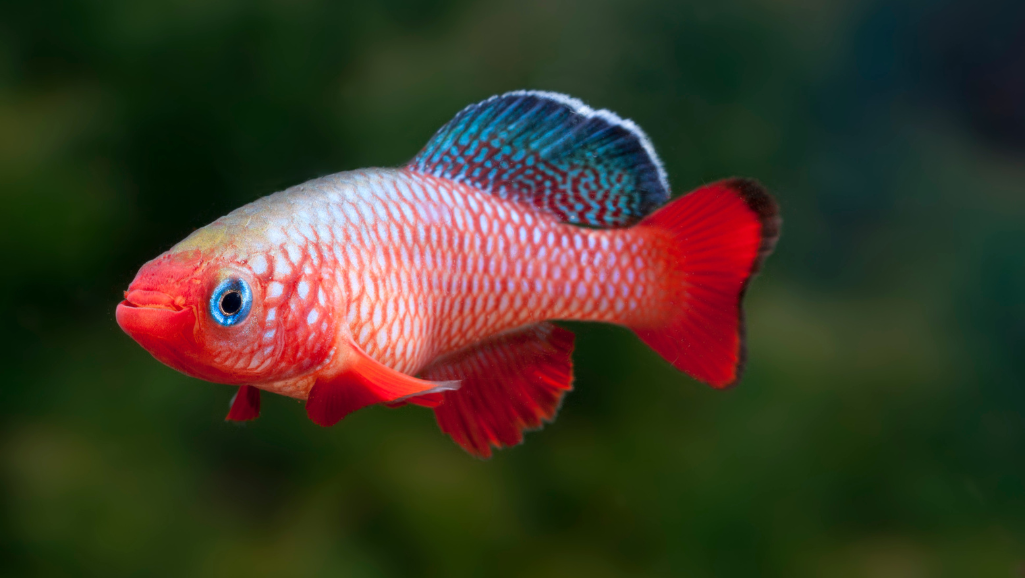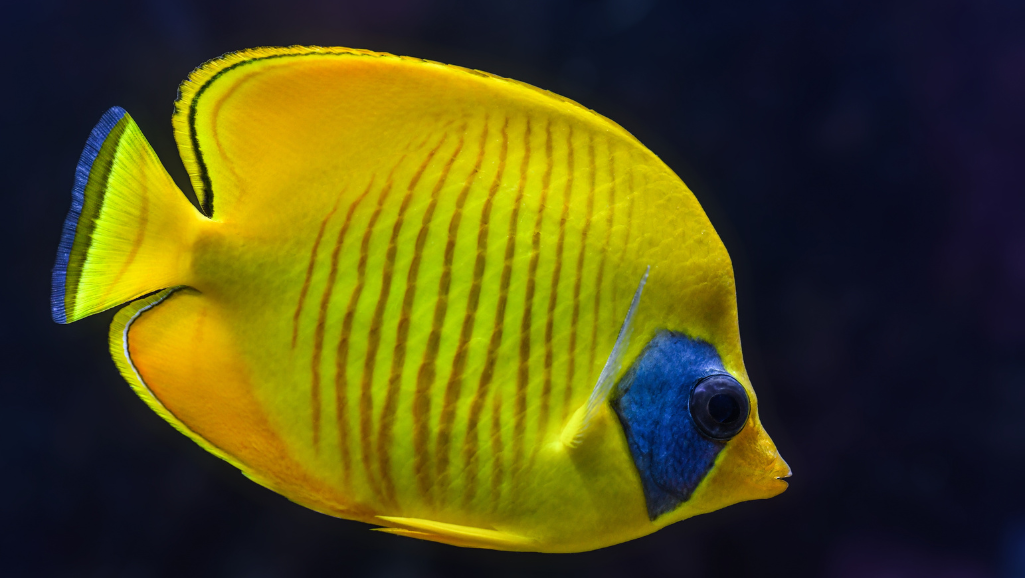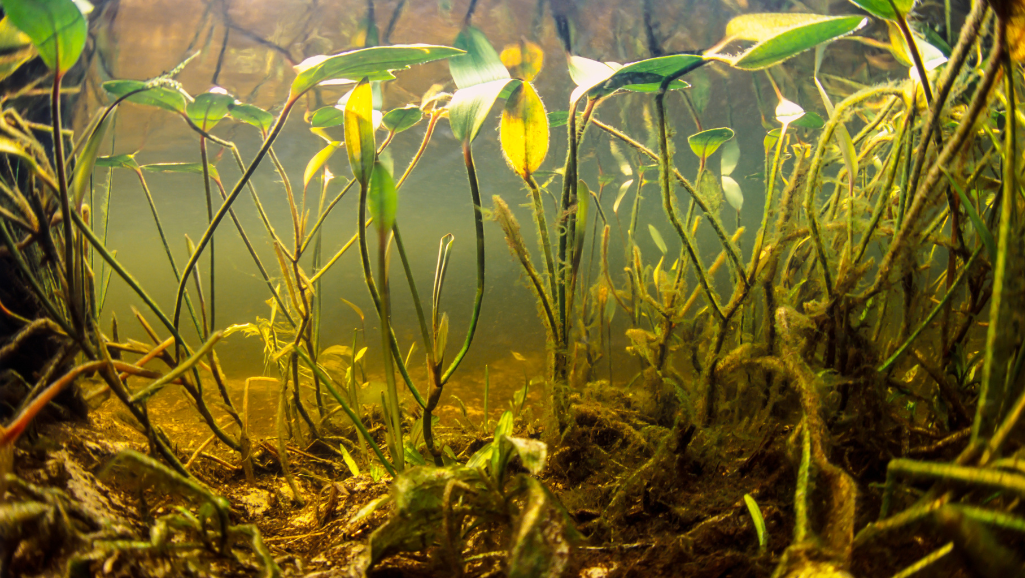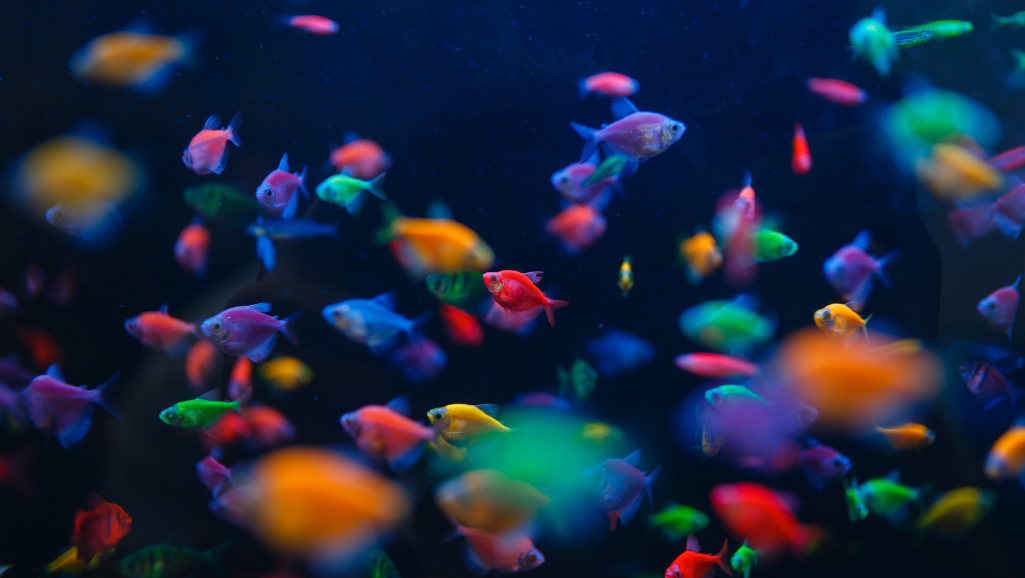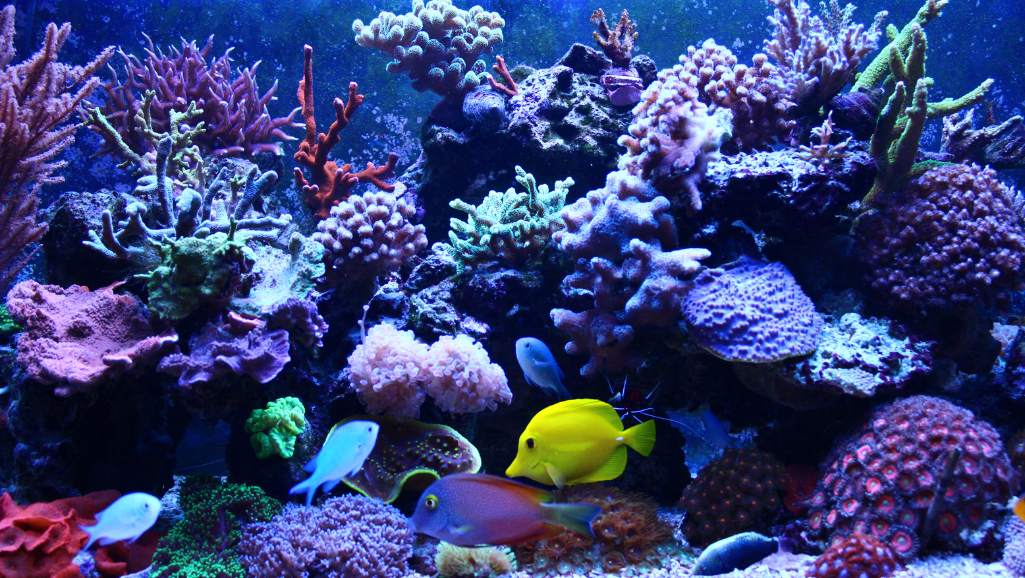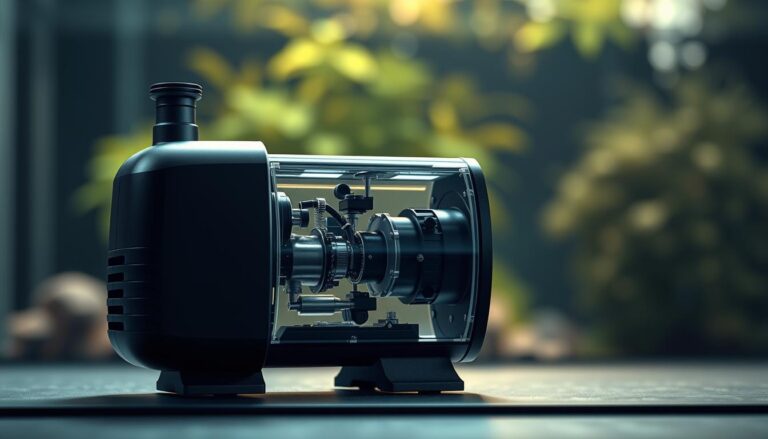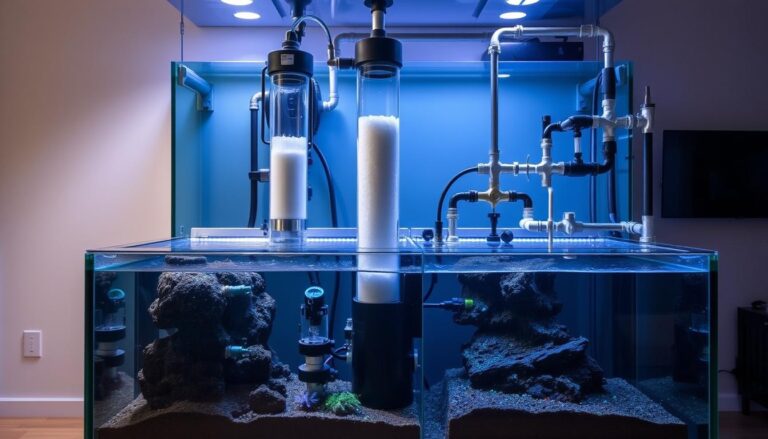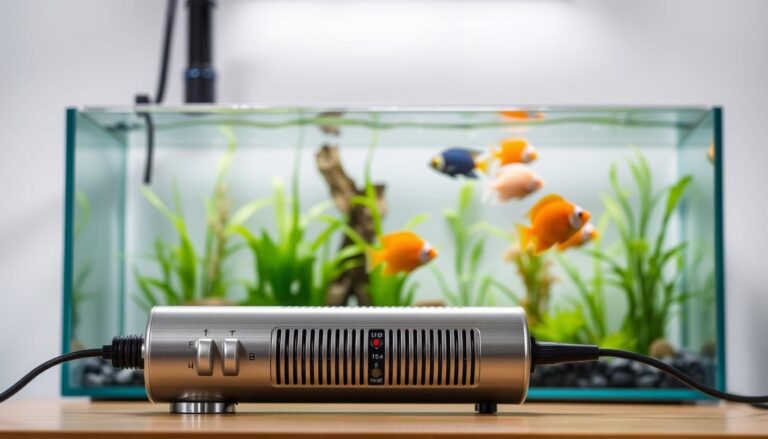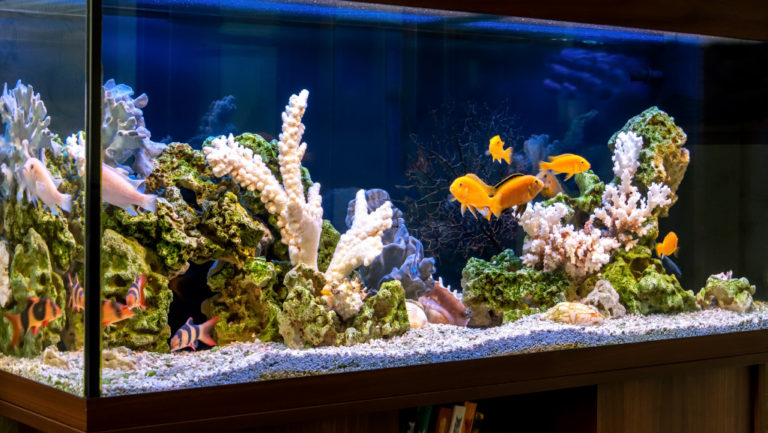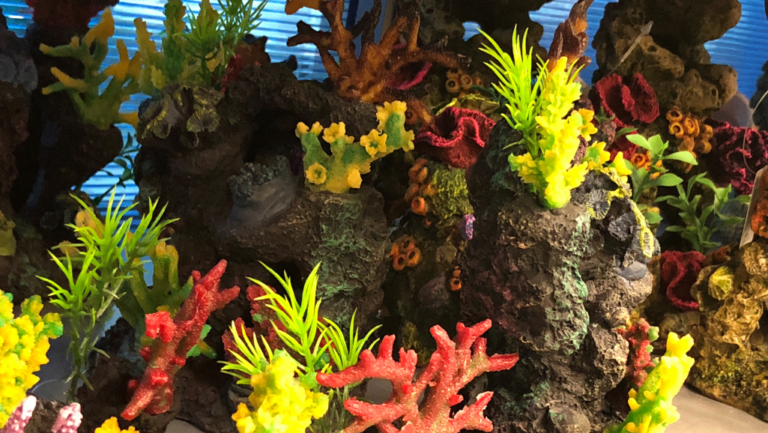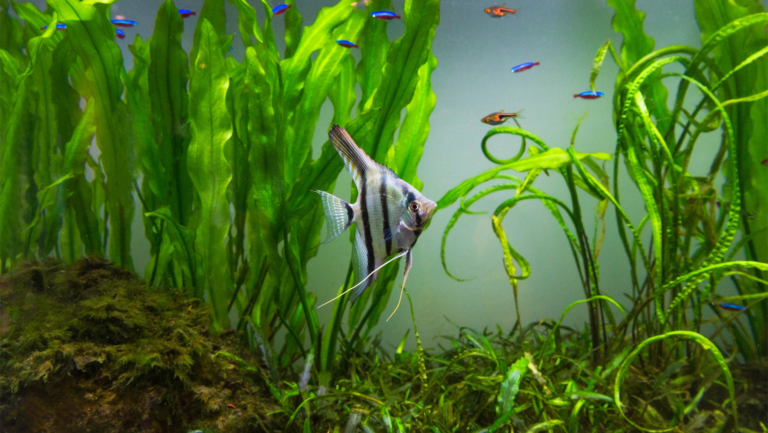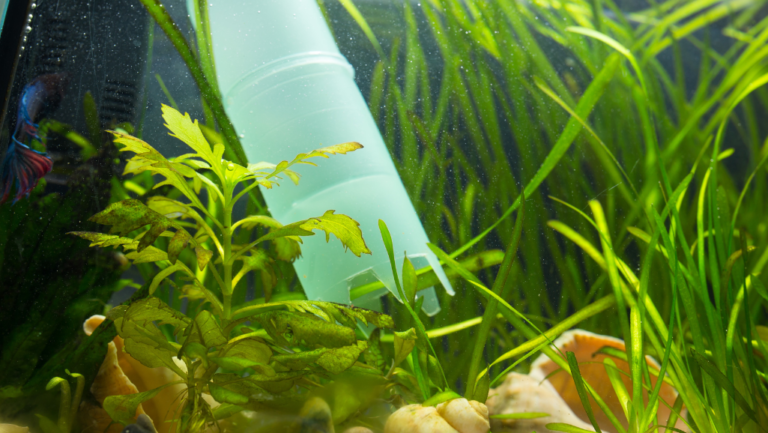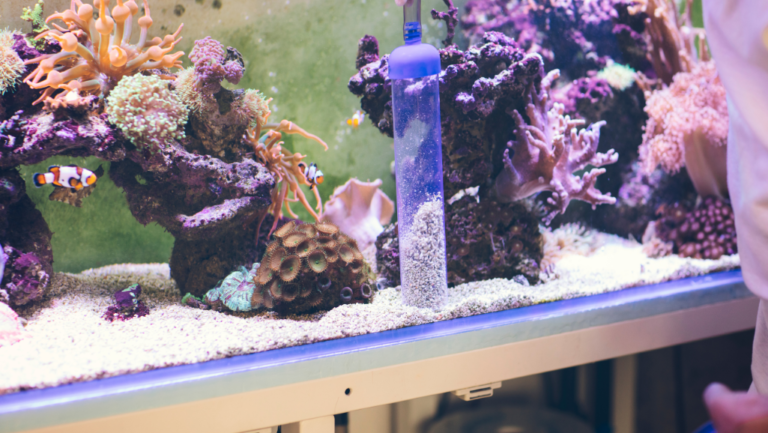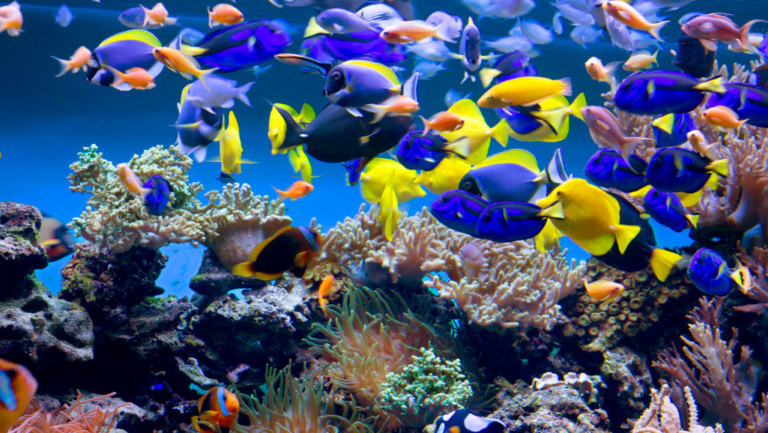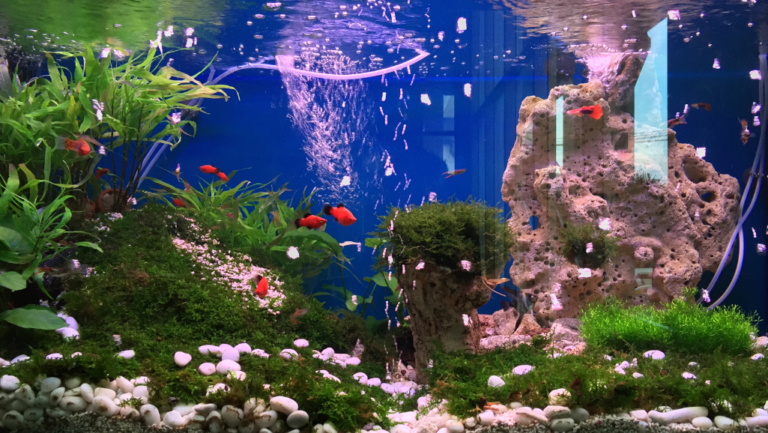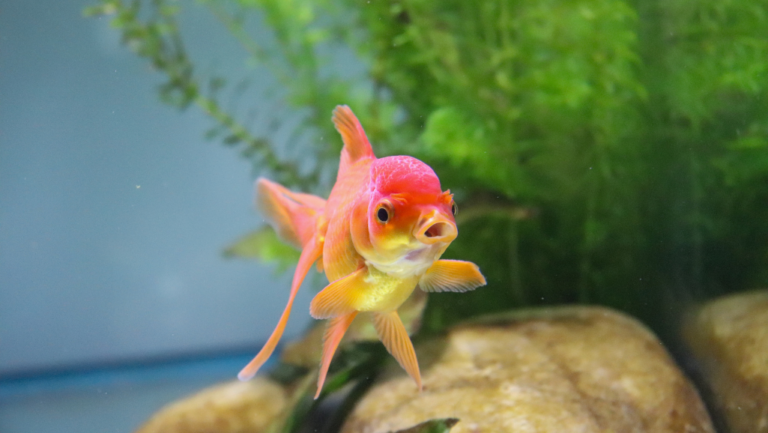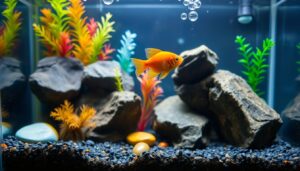Yellow or brown water in your fish tank can worry you. It’s not always bad, but finding the cause is key to keeping your fish safe. Often, it’s because of waste, uneaten food, or dead plants.
Recently, 17,000 people looked for ways to fix yellow water in their tanks. 34 people shared tips, and 10 were actively talking about it. Too much food can make the water turn yellow. To fix it, change 25-50% of the water every week.
There are many ways to make your tank water clear again. Filters, like mechanical, biological, and chemical ones, help a lot. Activated carbon is great for removing stuff that makes the water look bad. Live plants also help by eating up extra nutrients and making oxygen.
It’s important to check your tank’s water often. Use kits to test pH, ammonia, nitrate, and nitrite levels. This way, you can catch any problems early and keep your tank clean and clear for your fish.
Key Takeaways
- Yellow or brown tinted aquarium water often indicates dissolved organic material issues, not bacterial bloom.
- Testing water parameters like pH, ammonia, nitrite, and nitrate can help identify the root cause of discoloration.
- Regular water changes (25-50% weekly) and cleaning up decaying material are key for clear water.
- Mechanical, biological, and chemical filters, like activated carbon, help remove tannins and organic matter.
- Live plants improve water clarity by absorbing excess nutrients and producing oxygen through photosynthesis.
Understanding the Causes of Yellow Aquarium Water
Yellow or discolored aquarium water can be a problem for many fish keepers. It might not always mean a big issue, but knowing why it happens is key. With over 3.6K views on this topic, it’s clear many are looking for solutions.
Natural Tannins in Fish Tanks
Natural tannins from driftwood are a main cause of yellow water. These tannins can make the water look like the natural habitats of some fish. But, they can also lower the water’s pH, making it more acidic.
To lessen tannin effects, soak driftwood in a bucket and change the water daily. Boiling the driftwood for 48 hours and replacing the water often can also help.
Algae Blooms and Organic Waste
Organic waste, like fish waste and decaying plants, can also turn water yellow. This waste can cause algae and bacteria to grow, making the water look bad. To fix this, change the water regularly and keep the tank clean.
Using carbon filters and filter resins can also help remove waste. Don’t overfeed your fish, as uneaten food can add to the waste in the tank.
Chemical Imbalances
Chemical imbalances, like high nitrates and old tank syndrome, can also make water yellow. These problems happen when the tank’s bacteria can’t handle toxins. To solve these, test your water often and use reliable test kits like API.
If you find high levels, change the water and use beneficial bacteria supplements. Cycling new tanks and watching water levels can keep the tank healthy and prevent old tank syndrome.
The Importance of Water Clarity
Keeping your aquarium water clear is more than just making it look good. It’s key to your fish’s health. Clear water means a clean home for your fish, helping them stay healthy and fight off sickness.
Did you know only 10% of aquarium owners have water that’s crystal clear? This shows how important it is to take care of your tank. Achieving clear water is a big challenge.
Health Benefits for Fish
The health of your fish depends on the bacteria in their water. Less harmful bacteria means your fish can focus on staying healthy. To keep water clear, you need lots of biomedia for every pound of fish.
Enhancing Tank Aesthetics
A clear aquarium lets you see your fish’s colors and the beauty of your setup. Yellow aquarium water can ruin the look. Keeping your water clear makes your tank a stunning sight to share with others.
Preventive Maintenance
Proper filtration with high surface area, adequate flow rate, mature filter media, good aeration, and high protein food contributes to maintaining crystal clear and bacteria-free water.
Regular tank maintenance is vital. It stops harmful substances from building up. A consistent cleaning schedule helps catch problems early. This keeps your water clear and your fish happy.
Testing Your Aquarium Water Quality
Keeping your aquarium healthy and vibrant means regular water testing. If your water turns yellow or nitrate levels are high, it’s time to find out why. By testing and understanding the results, you can fix the water and keep your fish happy.
Essential Tests to Perform
To find out why your water might be yellow or nitrate levels are high, do these tests:
- Ammonia: Test and record ammonia levels once a week. Aim for 0 ppm.
- Nitrite: Test for nitrite monthly. Any increase means a problem. Try to keep it at 0 ppm.
- Nitrate: Test nitrate levels monthly, more often if you’re breeding fish. Keep it below 50 ppm, at least 20 ppm for plants.
- pH: Test pH monthly, or when there’s a fish death or illness. The ideal range is 6.5 to 8.0.
Also, check hardness, alkalinity, phosphate, and copper levels. Keeping these within the right range is vital for a healthy aquarium. Regular testing helps you catch and fix problems early. Learn more about regular water testing to keep your aquarium thriving.
Interpreting Test Results
After testing, it’s time to understand what the results mean. Yellow aquarium water can come from too much waste, algae, or natural tannins. High nitrates might mean your biofilter is too busy or you need more water changes.
Regular testing is key to catch changes in water due to new fish, food changes, or environment adjustments.
Compare your results to the ideal ranges for your aquarium. This helps you see what needs fixing. Remember, sudden changes can stress your fish. Always make small changes and test again to ensure stability.
Recommended Testing Kits
Getting reliable testing kits is important for accurate readings. Look for kits that are easy to use and offer many tests. Some good options are:
- API Freshwater Master Test Kit
- Salifert Nitrate Test Kit
- JBL ProScan Aquarium Water Analysis
Even experienced aquarists test regularly to keep their aquariums healthy. By testing often and fixing problems quickly, you can get rid of yellow water and control nitrate levels. Knowledge is power, and a clean, vibrant aquarium is the reward.
Immediate Actions to Clear Yellow Aquarium Water
If your aquarium water turns yellow, act fast to keep your fish healthy. Yellow water can come from many sources, like organic compounds, tannins, and bacteria. Follow these steps to clear your tank’s water quickly.
Water Changes: How and When
Changing a lot of water is a good way to fight yellow water. Experts say changing up to 50% of the water helps. Use a gravel vacuum to clean the bottom of the tank during a change.
Regular water changes and good tank care stop yellow water from coming back.
Using Activated Carbon
Activated carbon is great for clearing yellow water. It’s used in filters to remove tannins and organics. Seachem Purigen is a good choice for this.
Adding activated carbon to your filter keeps the water clear and healthy for your fish.
Employing a UV Sterilizer
UV sterilizers are also helpful for clear water. They kill algae and bacteria with UV light. This stops yellow or cloudy water.
Choose the right size UV sterilizer for your tank and follow the instructions for use.
“Cloudy fish tank water can lead to health complications for fish and should be addressed promptly.”
Act quickly to fix yellow water in your aquarium. Do regular water changes, use activated carbon, and think about a UV sterilizer. With care and the right steps, your aquarium will be clear and healthy.
Long-term Solutions to Prevent Yellow Water
To keep your aquarium water clear, you need to take care of it regularly. Quick fixes like water changes and activated carbon can help for a while. But, you also need long-term solutions to stop yellow water from coming back.
Using the right aquarium filtration, cleaning often, and picking the best substrate are key. These steps help keep your tank healthy and looking great.
Maintaining Proper Filtration
A good filtration system is vital for a healthy aquarium. It removes debris, breaks down waste, and keeps water stable. Make sure to clean or replace filter media and check water flow often.
Choose a filter that fits your tank’s size and how much waste it produces. A bigger filter means clearer water and a better home for your fish. Mixing different filters can make your water even clearer and better.
Regular Cleaning Routines
Keeping a regular cleaning schedule is key to avoiding yellow water. Change 10-20% of the water each week to remove waste and add minerals. Use a gravel vacuum to clean the substrate.
A little maintenance goes a long way in keeping your aquarium water crystal clear and your fish happy and healthy.
Also, clean decorations, rocks, and surfaces often to stop algae and organic matter buildup. Remove dead leaves and decaying matter from plants to keep water clear.
Choosing the Right Substrate
The substrate you pick can affect your water’s color and clarity. Some, like driftwood and certain sands, can make the water yellow. This might be what you want in some setups, but not always.
Go for substrates like gravel or sand that don’t change the water’s color or chemistry much. Vacuuming the substrate during water changes helps remove debris and waste that can turn the water yellow.
By following these long-term steps and keeping up with regular tank maintenance, you can avoid yellow water. This way, your aquarium will stay healthy and beautiful for many years.
The Role of Live Plants in Water Clarity
Live aquatic plants do more than just look good in an aquarium. They help keep the water clear and healthy. These plants act as natural filters, making your tank water crystal clear.
Plants help purify the water by removing nutrients that algae would use. This stops algae from growing too much. It keeps the ecosystem balanced.
Natural Filtration with Aquatic Plants
Each plant species has its own way of improving water quality. Water hyacinth grows fast and takes in nutrients, controlling algae. Hornwort removes toxins, and cattails clean heavy metals from the water.
“Duckweed can absorb excess nutrients and act as a natural water purifier, making it a valuable addition to any aquarium.”
Choosing the Best Plant Varieties
It’s important to pick a mix of floating, submerged, and marginal plants. This mix helps balance nutrient absorption and provides shade. But, make sure the plants fit well with your tank’s conditions.
Most plant problems come from bad lighting, not enough nutrients, or melting issues. Make sure your plants get the right nutrients through fertilization and tank maintenance.
Balancing Aquatic Life
It’s important to keep the right balance of fish and plants. This stops waste and nutrient build-up. Also, remove dead plants and control invasive species to keep the tank healthy.
By taking care of live plants, you’ll have a clear and thriving tank. It will support the health of your fish and other aquatic pets.
The Impact of Decorations on Water Color
Choosing the right decorations for your aquarium is key to keeping it healthy and looking good. From driftwood and rocks to artificial ornaments, each decoration affects your tank’s look and water quality.
Driftwood can make your water look yellowish or tea-colored. This is natural and safe for fish but might not be what you want. Artificial decorations can also cause problems if not kept clean. They can harbor algae and debris, leading to dirty water.
Natural vs. Artificial Materials
Think about the materials of your decorations. Natural items like rocks and wood should come from trusted aquarium suppliers. Make sure they are safe for your tank. Avoid rocks with metals that can harm your fish, like in low pH water.
For artificial decorations, like plastic plants, choose wisely. Most are safe, but some can break down or release toxins. Glass decorations are usually safe, but be careful with certain types that might have harmful substances.
Cleaning and Maintaining Decorations
Cleaning your decorations regularly is vital. Remove them during water changes and gently scrub them to get rid of algae and debris. Focus on areas where waste can hide.
Check your decorations often for damage. Replace any that are cracked or worn out. This keeps your tank safe for your fish and prevents water problems.
Best Practices for Safe Additions
When adding new decorations, follow important steps. Rinse them well with clean water to remove dust. Be careful with ceramics, as they might have harmful metals.
Don’t use shells or coral in freshwater tanks. They can change the water’s pH and hardness. Also, place decorations to ensure good water flow and avoid dead spots.
By choosing and caring for your decorations wisely, you can keep your tank water clear. Regular maintenance is essential for a healthy, beautiful aquarium.
How to Choose the Right Aquarium Fish
Choosing the right fish for your aquarium is key to a healthy and beautiful tank. The right mix of fish can make your water clear and your ecosystem balanced. Think about their compatibility, how much waste they produce, and if they can help fight algae and waste.
Species Selection for Cleaner Water
Some fish are great at keeping your aquarium water clean. Algae eaters like Siamese algae eaters and bristlenose plecos eat algae, keeping your tank clean. Bottom feeders like corydoras catfish and loaches eat leftover food and waste, stopping organic matter that can turn your water yellow.
When picking fish, look at their size, how they act, and what they need to live well. Doing your homework on each species will help you pick the right ones for a peaceful tank.
Compatibility and Bioload Considerations
It’s important for fish to get along in your aquarium. Some fish can be mean to others, causing harm or even death. Make sure the fish you choose can live together peacefully.
“Maintaining a balanced bioload is key to preventing yellow water and promoting a healthy aquarium ecosystem.”
The bioload is how much waste fish produce. Too many fish or ones that make a lot of waste can make your water bad and turn it yellow. Keep your fish count in check and watch your water’s health closely.
By picking fish that get along and don’t make too much waste, you can have a clean and healthy aquarium. Keep up with regular tank care, like changing water and using good filters, to keep your tank looking its best.
Implementing a Balanced Feeding Regimen
Keeping your aquarium clear is more than just cleaning. The food and feeding schedule you use are key. They help prevent yellow water and keep your fish healthy.
Many people make the mistake of overfeeding. This leads to too much waste and uneaten food breaking down. This can quickly raise ammonia and nitrite levels, causing yellow water and harming fish. So, it’s vital to have a balanced feeding plan.
Choosing High-Quality Fish Food
Start by picking high-quality, easy-to-digest fish food. Choose foods that are rich in nutrients and match your fish’s needs. Some say to feed your fish about the size of one eyeball of dry food every other day for the first two weeks. This helps cycle the tank.
Feeding Schedules for Optimal Health
Having a good feeding schedule is key for clear water and tank health. Feed small amounts, just what they can eat in a few minutes, two to three times a day. Take out any leftover food right away to stop it from breaking down and harming the water. A well-fed fish is a healthy fish, but too much food can cause problems, like yellow water.
“The key to a thriving aquarium is finding the perfect balance between providing your fish with the nutrition they need and maintaining a clean, healthy environment.”
By picking the right fish food and following a balanced feeding schedule, you can cut down fish waste. This helps keep your water clear and your fish happy and healthy. Add regular tank care, and you’ll have a beautiful, clear aquarium.
Troubleshooting Persistent Yellow Water
Even with the best care, your aquarium might turn yellow. This can be really tough to fix. But, with some detective work and the right solutions, you can make your tank clear again.
Identifying Underlying Issues
First, find out why your water is yellow. Things like fish waste, leftover food, and dead plants can make water look cloudy. Driftwood can also turn water yellow or brown, but it’s good for some fish from South America.
To figure out the problem, test your water often. Check pH, ammonia, nitrite, and nitrate levels. If ammonia or nitrite are high, change half the water to reduce toxins. Also, watch for foam on the surface, which means you need to clean up and check your filter.
When to Seek Professional Help
If yellow water lasts more than a month, even after trying different things, get help. A pro can help find out if it’s debris, plant decay, or a filter problem.
When you talk to a professional, tell them about your tank, how you take care of it, and any recent changes. They can help you find and fix the problem. This way, you can get your water clear again for your fish’s health and your enjoyment.
The Benefits of Regular Maintenance Routines
Setting up a regular tank maintenance schedule is key to avoiding yellow water. It also helps keep your aquarium thriving. Regular care makes sure your fish have a healthy and beautiful home.
Developing a Schedule
It’s important to plan out your aquarium upkeep. A good routine should include:
- Frequent water changes (10-15% every 1-2 weeks)
- Filter cleaning and maintenance
- Gravel vacuuming to remove debris
- Regular testing of water parameters (pH, ammonia, nitrites, nitrates, and hardness)
The tasks you need to do can change based on your tank’s size, fish number and type, and tank age. For instance, bigger tanks or those with more fish might need more water changes and filter upkeep.
Good bio filtration in an aquarium with well-maintained filters can allow a small aquarium to hold more fish or a large tank to maintain a healthy environment.
Tools and Supplies for Successful Care
Getting the right tools and supplies is vital for good aquarium care. Some must-haves include:
- A reliable gravel vacuum for removing debris and performing water changes
- Water conditioner to remove harmful chemicals and make tap water safe for your fish
- Test kits for monitoring water parameters (e.g., pH, ammonia, nitrites, nitrates, and hardness)
- Filter media (mechanical, biological, and chemical) for optimal aquarium filtration
With the right tools and supplies, you can make your maintenance easier. This keeps your aquarium a clear and safe space for your fish.
Inspiring Success Stories: Clear Tank Transformations
Seeing yellow aquarium water turn clear is truly inspiring. It motivates both new and seasoned aquarists. Many have overcome cloudy water challenges, thanks to hard work and good tank care.
Real-Life Examples from Aquarists
Online forums and social media are filled with success stories. There are 62 examples of fish tank makeovers. These stories show how the right methods and patience can clear yellow water.
Tips Learned from Experience
These success stories offer useful tips. Aquarists stress the need for regular water changes and good filtration. They also talk about the importance of patience and consistent effort.
Celebrating Clear Water Achievements
The community cheers on these successes. They congratulate and admire the creativity and hard work. Celebrating these wins boosts morale and inspires others to achieve clear water, building a supportive community.
